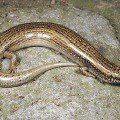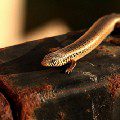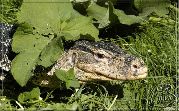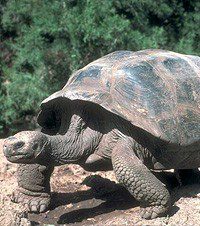
Spindle skink
If it were not for the legs located on the sides, then the spindle-shaped skink could easily be mistaken for a snake. All lizards of this genus have a serpentine body, though not as long as real snakes. This appearance of skinks is due to evolution, during which the number of fingers on the paws of lizards decreased, and the body lengthened. Modern fusiform skinks have short legs with 5 to 1 fingers, a body of about 50 cm, half of which is a tail, and are scientifically called chalcids. These lizards owe their second name “fusiform” to the specific shape of their body, resembling a spindle, thinning on both sides – head and tail. All skinks are thermophilic and live in the southern regions of Europe and Asia, as well as on the African mainland. These reptiles, like many others, do not particularly need moisture, so their habitats are most often dry. The most typical representatives of the chalcid genus include the five-toed fusiform eyed skink Chalcides ocellatus and the three-toed lizard Chalcides chalcides. And in total, there are about 15 species in the genus of spindle-shaped skinks. And almost all of them are viviparous and prolific – they are able to bring 10 small individuals every year. Some species of chalcids are listed in the Red Book, for example, the Far Eastern skink and the European bald eye.
Contents
Classification
Kingdom: Animals
Type: Chord
Class: Reptiles
Order: Scaly
Suborder: Lizards
Infraorder: Skinks
Family: Skink
Genus Chalcides – Chalcides, Cylindrical skinks, Spindle skinks, Rolled reptile
Appearance
Despite the fusiform shape, the body of the skinks from the genus Chalcid is still slightly flattened. The head of these lizards is slightly pointed, conical in shape, and the tail begins to thin out gradually. But the main feature of fusiform skinks is, perhaps, smooth scales. Each scale has a rounded or slightly diamond-shaped shape, thus resembling fish scales. Over the entire surface of the body of lizards, this scale is almost the same, while in representatives of other genera, the abdominal and lateral scales often differ. Only on the head of the skinks the shields are larger. Interestingly, the location of these scutes can determine the genus to which the skink belongs, so that the number of rows of scales around the body of the lizard is directly related to their generic taxonomy. It is worth noting that there are skinks with tuberculate, keeled and even spiked scales.
The internal structure of the skin of spindle-shaped skinks is also peculiar. Actually, under the horny scales, the body of lizards is covered with thin bone plates through which a system of special channels passes. These plates are called osteoderms and make the skink’s body dense and elastic to the touch. In addition, the skinks do not have the upper temporal fenestrae found in other reptiles – they are closed by skin ossifications that are tightly fused with the bones of the skull. But the ear holes are open, but the eardrum is located not on the surface, but in the depth of the ear canal. And the eyes of these lizards are also peculiar – not very large, with a round pupil and separate eyelids. The movable lower eyelid has a transparent window that allows skinks to see even with their eyes closed.
As for the ocellated spindle-shaped skink, this reptile has short legs and a body up to 125 mm, but the tail of different individuals can be of different lengths. The end of the muzzle of the skink is pointed and, as it were, extends over the edge of the jaws. The scales, like those of most chalcids, are smooth, only on the back they can be slightly ribbed. The auditory openings are larger than the nostril. The color of the ocellated fusiform skink is olive or bronze-brown. Along the ridge of the lizard and on the sides there are darker wide stripes, and also throughout the body, except for the belly, there are dark and light spots resembling eyes, which is why the reptile is called so. But there are also uniformly colored individuals. The belly of these skinks is light, without spots, and on the sides of the head there is a pattern of dark transverse strokes. The three-toed spindle-shaped skink is practically the twin of the five-toed eyed skink. In addition, the chalcids lack palatine, but have simple conical teeth attached directly to the jawbones, and scaly warts are located on the sagittate tongue.
Distribution and habitation
All types of spindle skinks are found in southern Europe, in the north and northeast of Africa, as well as in southwest Asia. The Asian habitat extends east to Iran, southern Turkmenistan and Pakistan. The ocellated fusiform skink on the Eurasian continent is found only in Central Asia, but if we take Africa as a starting point, then its range extends from the northeastern territories of the mainland north to Sardinia, Sicily and Greece, and east to Northwest India. In Europe, this spindle-shaped skink merged in the southeast – to southeastern Turkey, Saudi Arabia, Iraq and Iran.
Like all reptiles, chalcids prefer areas where it is easy to find shelter – various ruins or piles of rubble. Lizards prefer to live on hard rocky soils or in sandy foothills and semi-deserts, where dry vegetation is sparse, mainly shrubs and grasses. But sometimes spindle-shaped skinks also settle in cultural plantations, for example, in vineyards and orchards. Scientists note that in general, the habitat of these reptiles is limited to countries adjacent to the Mediterranean Sea.
Behavior and lifestyle
 Spindle skinks are flexible but slow creatures. They do not move very fast on the surface of the earth, and if they are caught, they will squirm violently and in doing so may break their tail in order to leave it in the hands or teeth of the enemy and run away. In winter, spindle skinks hibernate and may hibernate in groups. Caring for them in terrariums is easy, and besides, chalcides are quickly tamed. It should be remembered about several important rules necessary for the normal organization of the life of a spindle-shaped skink in a terrarium.
Spindle skinks are flexible but slow creatures. They do not move very fast on the surface of the earth, and if they are caught, they will squirm violently and in doing so may break their tail in order to leave it in the hands or teeth of the enemy and run away. In winter, spindle skinks hibernate and may hibernate in groups. Caring for them in terrariums is easy, and besides, chalcides are quickly tamed. It should be remembered about several important rules necessary for the normal organization of the life of a spindle-shaped skink in a terrarium.
These lizards are very fond of climbing, in the wild they often make their way through stone crevices, as they live mainly in mountainous areas. Therefore, skinks simply need various stones, snags, as well as shelters resembling caves. In addition, in the wild, skinks often burrow into soft soil, for example, if they live in sandy areas. So in the terrarium, it is desirable for them to provide suitable soil. And finally, spindle skinks are very picky about the ambient temperature. On hot days, they themselves choose suitable places to bask in the sun. To do this, lizards often climb up the stones or, conversely, go down lower if it is too hot at the top. When installing an ultraviolet lamp in a terrarium, it is necessary to take care of the surface on which the skink will bask. It is better to place it at an angle, so that the lizard itself chooses the optimal height and proximity to the heat source. Care should be taken to place the pet with special electric heaters that imitate stones heated by the sun, as the lizard can burn itself.
Despite the slowness that spindly skinks show on open surfaces, they move quite rapidly under the surface of the earth. The spindle-shaped body of lizards is adapted to such movements, and in terms of strength and dexterity they are even compared with the original inhabitants of the dungeons – moles. Researchers observing skinks in terrariums have noted that these lizards do not just burrow, but seem to dive into the sand and tear it in all directions and at various depths. There is a feeling that the spindle-shaped skinks swim in the sand, and their movements can be observed by the fluctuation of the ground surface.
Chalcids even hunt while underground. If the skink manages to “smell” some tasty worm on the surface, then it will immediately approach it and “take a sample”, touching the prey with its tongue from below, from under the ground. Having determined that the food is suitable, the lizard sticks its head out and grabs the worm, either hiding with it underground or going outside.
Spindle skinks are popular pets in home terrariums because they are beautiful and cause little to no trouble. However, people, due to their ignorance, massively destroy these lizards in the wild, considering them poisonous because of their resemblance to snakes. This is especially true for residents of the remote islands of the Mediterranean Sea, who are poorly versed in the features of the local fauna.
Food
 In nature, spindle-shaped skinks prey on various small terrestrial creatures – worms, snails, insects. The ocellated lizard is especially successful in this. She does not refuse both arachnids and insect larvae found, as well as various invertebrates. In general, this lizard is moderately omnivorous and voracious. So in a nursery or terrarium, it is desirable to make up the diet of a skink from animal feed. Small cockroaches, zoofobas, various medium-sized crickets, self-bred mealworms and even newborn rodents are suitable for feeding. Sometimes skinks are fed with baby food, various fruit purees. It is better to give such liquid food to lizards in a bowl, and they will willingly lick the soft gruel from it. Don’t forget about vitamin supplements. Particularly useful for fusiform skinks are those that contain calcium. Some sources of information about chalcids note that they can be given meat from time to time, but most experts still do not advise accustoming a serpentine pet to such food. Meat is allowed only lean, chicken or beef, as well as boneless fish. But you should not give his skink more than once a month.
In nature, spindle-shaped skinks prey on various small terrestrial creatures – worms, snails, insects. The ocellated lizard is especially successful in this. She does not refuse both arachnids and insect larvae found, as well as various invertebrates. In general, this lizard is moderately omnivorous and voracious. So in a nursery or terrarium, it is desirable to make up the diet of a skink from animal feed. Small cockroaches, zoofobas, various medium-sized crickets, self-bred mealworms and even newborn rodents are suitable for feeding. Sometimes skinks are fed with baby food, various fruit purees. It is better to give such liquid food to lizards in a bowl, and they will willingly lick the soft gruel from it. Don’t forget about vitamin supplements. Particularly useful for fusiform skinks are those that contain calcium. Some sources of information about chalcids note that they can be given meat from time to time, but most experts still do not advise accustoming a serpentine pet to such food. Meat is allowed only lean, chicken or beef, as well as boneless fish. But you should not give his skink more than once a month.
Reproduction
The process of reproduction in fusiform skinks is classified into two types: chalcids, predominantly viviparous or ovoviviparous. In a real live birth, skink embryos in the mother’s womb nourish the blood vessels located in the walls of the oviducts. Such reproduction is characteristic of the aforementioned typical European chalcid Chalcides ocellatus. His offspring is born into the world, covered with a thin embryonic film, which, when leaving the womb, is eaten by itself. And, of course, the process of birth is preceded by mating games.
Male spindly skinks are by nature more aggressive than females, but they are no stranger to courtship, expressed in shaking their heads when meeting a suitable female. After fertilization, the belly of the female skink begins to increase, this becomes noticeable after about 2 weeks. In artificial conditions, a pregnant reptile needs to create a semblance of a nest, and in nature it chooses and equips a shelter on its own. The time of gestation of embryos in different types of spindle-shaped skinks ranges from 2 weeks to 2-3 months. Babies are happy to eat insects.
Sources of
http://www.floranimal.ru
http://zoodv.ru
http://ru.wikipedia.org
http://www.ecosystema.ru
http://www.wikiznanie.ru
http://www.rocka.ru/
http://www.reptisib.ru





